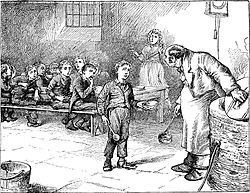 There is an iconic scene in the musical Oliver in which the young orphan Oliver Twist approaches Mr. Bumble, the workhouse supervisor, and asks for a second bowl of gruel. Bumble’s enraged reaction is “More! You want more?!!” In his mind, the little whippersnapper had unmitigated gall to request seconds. The firsts were more than generous.
There is an iconic scene in the musical Oliver in which the young orphan Oliver Twist approaches Mr. Bumble, the workhouse supervisor, and asks for a second bowl of gruel. Bumble’s enraged reaction is “More! You want more?!!” In his mind, the little whippersnapper had unmitigated gall to request seconds. The firsts were more than generous.
This, of course, put me in mind of fundraising. (While my mind may not have only one track, the number is clearly limited.) In a situation in which one-way charity is the nature of the relationship, the receiver is utterly at the mercy of the whims (and circumstances) of the giver. No fundraising can be truly successful or enduring if it is built upon a supplicant relationship. It must be an exchange between equals. Funds are received and the opportunity to support something worthwhile (and meaningful to the giver of funds) is provided in return.
There are only two scenarios in which fundraising is not a form of supplication. In one, the recipient has a sense of entitlement. They know they deserve receiving the money and expect it to be given. In the other, the recipient is aware of the benefit that the giver will experience and the giver is equally aware of it.
In the arts, there are some who value themselves and/or their organizations so highly that they expect people to give because their work is so noble, so essential. (Granted, few frame it that way in their own minds.) Some who don’t believe this feel, in their heart of hearts, that their only available framework is charity.
The mutual benefit model comes into play in circumstances where current supporters (the usual suspects) don’t need convincing. They already understand for themselves the benefits (either aesthetic or social) of the arts and give to those ends. However, if the pool of donors needs to be expanded, the only way to attract new people or institutions is to have them understand the value to them or their interests of the work the arts organization does. In some cases this may be possible by better articulating that work, but in most others, it will be necessary to be doing things that make recognition of that value inescapably obvious.
It is doing things of palpable value, understood by the public as valuable, that is the result of community engagement. As such, community engagement is one of the best tools for expanding an arts organization’s funding base.
More soup, anyone?
——————————–
Point of personal privilege: I had the great good fortune to participate in the Canadian Arts Summit last weekend. (Thank you Banff Centre and Business for the Arts.) Banff has been on my bucket list for decades and, even though there were no crystal clear days, the scenery is mind-blowingly gorgeous. But better, the Canadian arts leadership assembled there is passionate, articulate, and very, very savvy. It was wonderful to share ideas with them. More will follow from me about these things later!
——————————–
Engage!
Doug
Image source: http://hu.wikipedia.org/wiki/Twist_Olivér_(regény)
